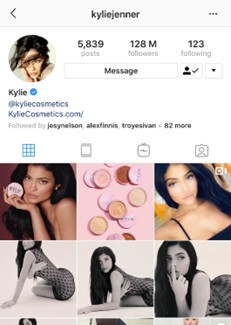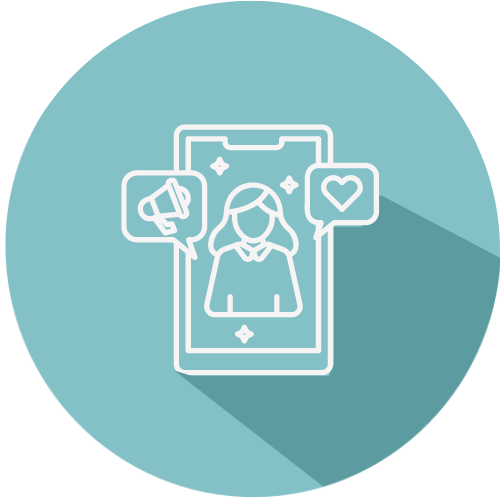The psychology behind influencer marketing
Relevant topics Archive, Strategy
Picture this: You’re mindlessly scrolling through your Instagram feed, and there she is – Kylie Jenner, effortlessly flaunting the latest makeup trends. Now, Kylie is not just a reality TV superstar; she's a mega influencer with millions of followers. When you see her sharing her makeup tips and product recommendations, you can't help but feel a sense of wishful identification. You admire her glamorous lifestyle and think, "Maybe I can achieve a touch of that too!" It's like having a front-row seat to the world of luxury. These feelings of identification with Kylie spark a desire to emulate her, and suddenly, those makeup products she's endorsing become must-haves in your beauty routine.

Now, let's shift to the world of sports and fitness. Cristiano Ronaldo, the football legend, isn't just known for his incredible skills on the field; he's also a mega influencer with a massive following. When you watch his training videos and see his dedication to fitness, it's hard not to feel a sense of similarity. You think, "I can hit the gym and get fit like Ronaldo!" This perceived similarity stirs up a positive emotional connection and motivates you to invest in fitness equipment and supplements endorsed by him. It's like having your personal fitness guru.
These two examples of Kylie Jenner and Cristiano Ronaldo perfectly illustrate the psychological principle at play in influencer marketing. When regular people feel a connection or really want to be like famous influencers, it sets off a series of emotions that affect how they act.
Can Influencers motivate us to improve?
Companies have caught on to including influencers as a part of their strategy. Hoping to win the hearts (and wallets) of their customers. Recently a research paper uncovered how Gen-Z consumers relate, identify, and compare themselves to influencers.
A recent study showed that when consumers see influencers as similar to themselves, it triggers ‘assimilative comparison emotions’, basically saying “Hey, I can be like them!”. On the flip side, if a consumer feels that they’re super different from the influencer, it triggers ‘contrastive comparison emotions’. This is where the consumer feels a lower sense of control, inferiority and thinking others are just lucky.
It is important to note that even though these feelings are completely opposite (‘I can be like them’ vs ‘I’m nothing like them’), both types of these comparison emotions affect how motivated people are to follow the influencer for self-improvement. If you feel similar, you're more likely to want to learn from them. But if you're wishing to be like them, it can also motivate you to take action to improve yourself.
Interestingly, when people feel both positive and negative emotions toward an influencer, it actually pushes them to want to better themselves. This, in turn, makes a customer like the influencer's products and want to buy them, and they engage more with the influencer's posts, like leaving comments or sharing.
What does this mean for my marketing strategy?
As a marketer, when you pick an influencer to represent your brand, make sure they’re someone your audience can relate to. It's not all about looks; it's about shared beliefs and characteristics. If they're seen as a role model, that's the jackpot!
In addition, if your influencer shows how your product can help followers improve themselves, even in the face of contrastive emotions, you're on the right track. People will be more motivated to follow your brand and buy your items.
For instance, if you're promoting eco-friendly products, team up with influencers who are passionate about sustainability. Instead of partnering with a high-fashion model, you collaborate with an influencer who's known for their sustainable lifestyle. They regularly share tips on reducing waste and living a green life. Your audience, which includes environmentally-conscious consumers, will find this influencer relatable and be more inclined to trust their recommendations. This creates a genuine connection between the influencer and your audience. Remember, authenticity is key.
This insightful study does have some pointers to be wary of. Firstly, there were more female Gen-Z participants than male Gen-Z, so we can’t say that these results apply to everyone across the board. Next, most of the influencers in this study had massive followings (more than 100,000). These results may or may not apply to smaller micro or nano influencers. Lastly, the study found some interesting connections between consumers' feelings and influencer marketing, but it couldn’t prove which is causing which. It’s like trying to figure out if the chicken came before the egg. This is a huge issue for the findings - requiring more research to dig deeper.
Speaking of digging deeper, future neuromarketing studies should experiment with how consumers view influencers. Are they seen as glamorous lifestyle icons, or do they embody values and traits? This is crucial because if we encourage customers to chase influencers' lavish lifestyles, we might unintentionally stir up materialism.

